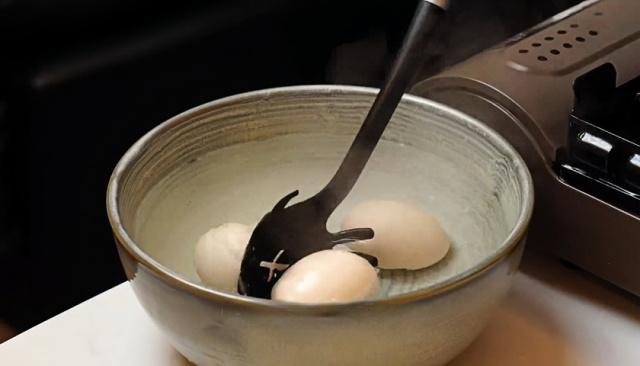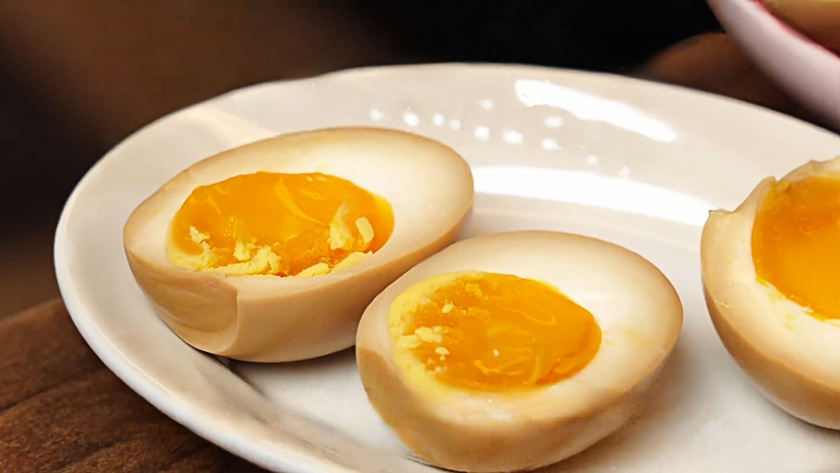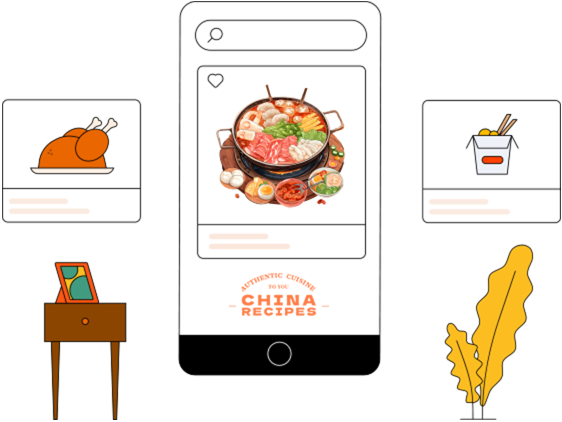Soy Sauce Soft-Boiled Eggs - Deliciously Exploding Yolk

Today, we're going to make the soy sauce soft-boiled eggs that many people have recommended recently. They're great for pairing with noodles or having with rice, and the recipe is really simple.
What are soy sauce soft-boiled eggs?
Soy sauce soft-boiled eggs are a snack made by boiling eggs at a low temperature for a short time to form a semi-runny yolk, and then marinating them in a soy sauce-based sauce in the refrigerator.
They have a savory and fragrant taste, as well as a tender and bursting texture. They are often served as a side dish for ramen, a snack to go with drinks, or a garnish for breakfast.
Comparison of boiling times for eggs
3 - 5 minutes: The yolk is liquid, and the egg white is soft but not fully set.
6 minutes: The yolk is liquid, and the egg white is fully set.
7 minutes: The yolk is sticky, and the edges are set.
8 minutes: The yolk is semi-set.
9 minutes: The yolk is semi-set.
10 minutes: The yolk is mostly set.
INGREDIENTS
Main Ingredients
-
·4 eggs (room temperature is best)
-
·3 coriander roots(or stems if roots are unavailable)
-
·30g onion (about 1/4 cup chopped)
-
·1 green bell pepper (about 1/2 cup chopped)
-
·1 bird's eye chili
Seasonings
-
·100ml light soy sauce(about 1/2 cup)
-
·20g sugar (about 1 tablespoon)
-
·5ml Chinese prickly ash oil or sesame oil (about 1 teaspoon)
COOKING STEP
Step 1
Add 1.5L of water to a pot and bring it to a boil. Then turn to medium-low heat to keep it simmering gently (small bubbles on the water surface).
Use a long-handled spoon to gently slide the eggs into the pot (avoid dropping them directly to prevent cracking). The amount of water should completely cover the eggs.
Cook over medium-low heat for 6 minutes and 30 seconds.

Step 2
As soon as the time is up, immediately remove the eggs and soak them in ice water for 10 minutes. Then peel them and set aside.

Step 3
Prepare the ingredients: Chop the coriander roots, onion, green bell pepper, and bird's eye chili and set aside.

Step 4
Make a sauce: 100ml light soy sauce + 200ml drinking water + 20g sugar + 5ml Chinese prickly ash oil or sesame oil. Stir until the sugar melts, and then add the chopped ingredients just prepared and mix well.

Step 5
Put the eggs into the sauce, seal, and refrigerate overnight.

Step 6
Early the next morning, take out the eggs. They should already be brown. Cut one open and check. The yolk is in the semi-runny state I want.
If you prefer a runnier or more cooked yolk, you can add or subtract 30 seconds based on the 6 minutes and 30 seconds. The perfect doneness is the one that suits you best.

More Recipes Worth Trying
Golden Coin' Egg:Spicy Fried Boiled Eggs from Hunan
Recipe Tips
1.Techniques to prevent eggshells from cracking when boiling eggs:
Water temperature control: After the water boils, turn to medium-low heat to avoid the eggs cracking due to the violent rolling of the water.
Adding white vinegar/salt: You can add 1 teaspoon of white vinegar or 1 teaspoon of salt to the water. The eggshells will be more resistant when exposed to acid/salt (the risk of cracking is reduced by 50%).
Transition between hot and cold: Take eggs out of the refrigerator 1 hour in advance to come to room temperature, or soak them in warm water for 10 minutes to reduce the impact of temperature difference.
2.Quick cooling to lock in the soft yolk:
Ice water bath: Immediately after boiling, soak the eggs in an ice water mixture (ice cubes + cold water) for 10 minutes to quickly stop the cooking process. This makes it easier for the yolk to form a perfect soft texture.
Changing the water halfway: If the ice water warms up, you can change the ice water once and continue soaking. This is especially suitable for operations in summer.
3.Adjusting the saltiness of the sauce:
After making the sauce, take a small dish and dip a cooked egg in it to taste. Adjust the amount of light soy sauce or sugar according to your taste (to avoid spoiling a whole pot of eggs).
4.Do not reuse the sauce:
After marinating eggs, bacteria are likely to grow in the sauce. It is recommended to use it up in one go.

Recipe Variations
1.Changing the flavor of the sauce
Japanese ultra-fresh version: Replace 100ml of light soy sauce with 50ml of mirin + 50ml of usukuchi soy sauce, and add 1 teaspoon of bonito flakes (soak for 10 minutes and filter before use).
Korean sweet and spicy version: Replace 100ml of light soy sauce with 50ml of Korean soy sauce + 20ml of apple cider vinegar + 15g of honey. Add 1 spoon of Korean chili paste + minced garlic (fry in advance).
Southeast Asian sour and spicy version: Replace 100ml of light soy sauce with 30ml of fish sauce + 20g of palm sugar + 10ml of lime juice. Add chopped lemongrass + ginger pieces.
2.Free combination of ingredients
Reduced-spiciness version: Replace the bird's eye chili with sweet peppers (not spicy) + 1/4 teaspoon of chili powder (slightly spicy for flavor).
Enhanced aroma version: Add 1 clove of minced garlic (fry and mix in) + 1 lemon leaf (torn up, fresh and refreshing to relieve greasiness).
Vegetarian version: Replace light soy sauce with vegetarian oyster sauce, and replace drinking water with kelp stock (bring to a boil and then cool down). The umami flavor will be more mellow.
3.Customizing the doneness guide
5 minutes and 30 seconds: The center of the yolk flows like lava. It is suitable for dipping directly in soy sauce or mixing with natto/cold tofu.
6 minutes and 30 seconds: The yolk is semi-set, and the center is slightly soft. It is the perfect partner for ramen, donburi, and sandwiches.
7 minutes and 30 seconds: The yolk is almost fully cooked, but the center is slightly moist. It is suitable for children's meals or salads, providing a more reassuring texture.
Serving Suggestions
1.Classic combination formulas
Breakfast CP: Cut the soft-boiled egg in half and place it on top of hot rice/porridge. Sprinkle with seaweed flakes + sesame seeds and drizzle with a little sauce. One bite will be amazing.
Soul of ramen: Cut the soft-boiled egg in half and put it into tonkotsu ramen. The yolk liquid will coat the noodles, and the umami flavor will hit the sky!
Best snack for drinks: After refrigerating, slice the eggs and arrange them on a plate. Serve with umeshu/sake. The salty, sweet, and slightly spicy taste is very refreshing and will be the centerpiece of the gathering.
2.Secrets of preservation and reheating
Refrigeration preservation: You can store them in an airtight container in the refrigerator for 3 days.
Reheating techniques:
Microwave on medium power for 10 seconds: The yolk will maintain its soft and runny texture, suitable for lazy people to heat.
Steam in a water bath for 2 minutes: The yolk will be fully cooked, and the texture will be more delicate. This is suitable for children or the elderly.
3.Creative eating ideas
Soft-boiled egg sandwich: Spread avocado paste on toast and sandwich with smoked salmon + soft-boiled egg. Use the yolk liquid instead of mayonnaise. It's low in calories and satisfying.
Soft-boiled egg with tofu: Place soft tofu at the bottom, put the cut soft-boiled egg on top, and drizzle with sauce + bonito flakes + scallions. It gives the impression of a Japanese chawanmushi.
Soft-boiled egg salad: Cut the eggs and mix them with kale + roasted pumpkin + walnuts. Use the yolk liquid instead of salad dressing to instantly upgrade your healthy meal.
FAQs:
Solution:
Precise timing: 6 minutes and 30 seconds of cooking over medium-low heat is the basic time. Adjust according to the heat:
If the heat is too high → subtract 10 seconds (e.g., 6 minutes and 20 seconds).
If the heat is too low → add 10 seconds (e.g., 6 minutes and 40 seconds).
Taste test verification: When making them for the first time, you can first boil 1 egg to test the doneness and then process in batches.
Solution:
Ice water bath is the key: Immediately after boiling, soak the eggs in ice water for 10 minutes. Use the principle of thermal expansion and contraction to separate the eggshell from the egg white.
Peel after refrigeration: If time permits, refrigerate for 2 hours before peeling. The success rate will double.
Peeling technique: Crack the eggshell at the large end, gently pry open the gap with a small spoon, and roll the shell off along the egg body.
Solution:
Prolong the marinating time: It is best to refrigerate for more than 12 hours. If time is limited, you can prick small holes in the egg white with a toothpick to speed up the flavor absorption.
Sauce ratio: Ensure that the sauce completely covers the eggs, or turn them over once during marinating.
Adding aroma ingredients: Add spices such as minced garlic, ginger slices, and lemon leaves to enhance the flavor penetration.
Solution:
Standard ratio:
For 4 eggs → The amount of sauce needs to completely cover the eggs (about 300ml of sauce).
When increasing the number of eggs, scale up the sauce proportionally:
For 6 eggs → 150ml of light soy sauce + 300ml of water + 30g of sugar + 7.5ml of Chinese prickly ash oil.
Container selection: Use a flat and airtight box to maximize the contact area between the sauce and the eggs.

















